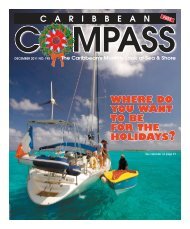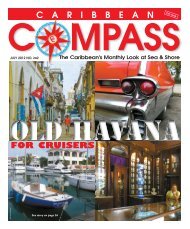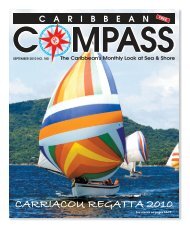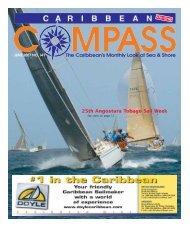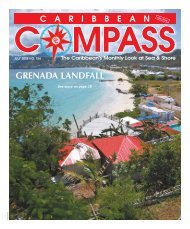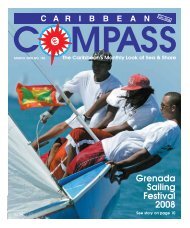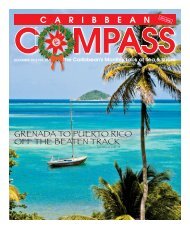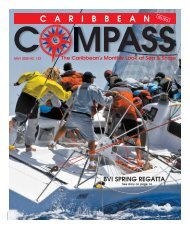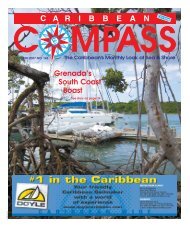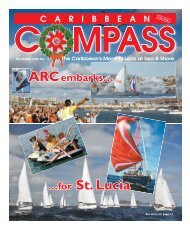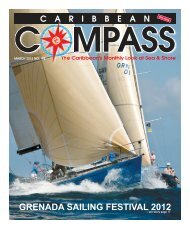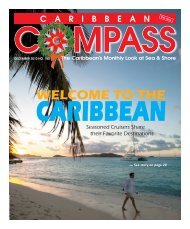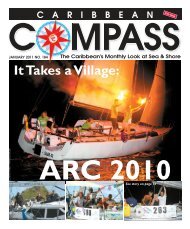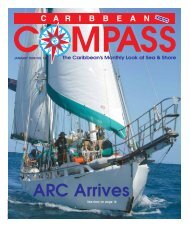Carriacou Regatta Festival 2007 - Caribbean Compass
Carriacou Regatta Festival 2007 - Caribbean Compass
Carriacou Regatta Festival 2007 - Caribbean Compass
Create successful ePaper yourself
Turn your PDF publications into a flip-book with our unique Google optimized e-Paper software.
—Continued from previous page<br />
Kalinago Caribs play an important part in the historical<br />
lore of St. Kitts, though sadly most noted for<br />
their last stand against British and French invaders<br />
and their final massacre at Bloody Point. It was here<br />
we were taken the next day by a very interesting<br />
Kittitian of old European descent, Greg Pereira. Greg<br />
Gli Gli’s arrival in St. Kitts, where Kalinago Carib lore<br />
plays an important part in local history<br />
has a lifelong passion for the pre-Columbian history of<br />
his island and has made a business sharing that<br />
knowledge as a tour company owner. At Bloody Point<br />
we were met by a large group of school children and<br />
their teachers, who accompanied us on the walk to<br />
Bloody River to see the site of the massacre and the<br />
numerous petroglyphs carved on the cliffs. This was a<br />
very moving place for everyone in the group. John<br />
Francis, the Gli Gli project’s co-director, led a ritual of<br />
remembrance for the fallen ancestors by singing the<br />
ancient Carib spirit-calling songs. We also took the<br />
opportunity to hold a minute’s silence in honour of<br />
Prince Hamlet, one of the key men on the 1997 Gli Gli<br />
expedition, who passed away three years ago.<br />
We left Bloody River to visit the old British fortress<br />
at Brimstone Hill where, in one of the store rooms,<br />
Paulinus discovered the bones of some of the victims<br />
of the Bloody River massacre packed up in cardboard<br />
boxes. We all gathered around to contemplate this<br />
physical encounter with the remains of the souls we<br />
had just been with. It was something of a shock to be<br />
holding the skulls of those who fell 400 years before.<br />
Paulinus made a pledge to ensure that the authorities<br />
of St. Kitts show due respect to his ancestors and<br />
rebury their remains in a monument to their honor.<br />
St. Kitts was a powerful experience for the Gli Gli<br />
crew. We were sorry to have to leave so soon, but we<br />
made sure we took our host Hazel for a sail in the harbour<br />
and Greg a passage to Nevis, where we prepared<br />
for the crossing to St. Barths.<br />
St. Barths<br />
The St. Barths crossing began with fair breeze. We<br />
had an enlarged flotilla as three yachts from Antigua<br />
had caught up with us: Rush, Jadie and Cooie. This<br />
gave our camera crew the first opportunities to shoot<br />
Gli Gli and Fiddler’s Green sailing together.<br />
We were also glad of the extra safety boats, had we<br />
needed them. Gli Gli’s most dangerous point of sail is<br />
dead downwind in rolling seas and as we lost sight of<br />
St. Kitts in the Sahara haze the swells started to pick<br />
up, nearly swamping us a couple of times. Etiene<br />
“Chalo” Charles, builder and captain of Gli Gli, called<br />
for shortened sail, so we dropped the sprit and retied<br />
the upper clew three feet lower down on the bamboo.<br />
We haven’t reduced sail in this way before; normally<br />
we take out the sprit completely and sail with a folded<br />
lateen rig. However it worked very well to reduce<br />
the roll of the canoe as we slid down the swells, allowing<br />
us to continue safely through the afternoon heat<br />
to St. Barths.<br />
Having waited a while at the eastern tip of the island<br />
for Fiddler’s to catch up and deliver the drums and<br />
cameraman, we made our way into Gustavia. We were<br />
greeted by a happy gathering — something close to the<br />
elite of St. Barths, including our good friends Lou Lou<br />
and Jenny Magras, our very gracious host Daniel<br />
Blanchard (an ex-mayor, now in charge of Club<br />
UNESCO), Raymond, Lou Lou’s brother (another exmayor),<br />
and the current mayor, Bruno Magras, and<br />
his deputy Yves Greaux. A bond of language was<br />
immediately made between the Carib crew and our<br />
hosts, who all spoke the same Creole French.<br />
The Gli Gli crew was given very special treatment by<br />
Club UNESCO. We were accommodated in the municipal<br />
lodge, used for visiting sports teams, and we were<br />
provided with a mini-van. Our cultural expedition<br />
turned into something of a relaxing island sojourn for<br />
a few days, a big change from the confined conditions<br />
and hammock-and-mat sleeping routine aboard<br />
Fiddler’s Green.<br />
The pre-Columbian heritage of St. Barths is somewhat<br />
lost in the cosmopolitan luxuries of this once<br />
tranquil island. Aside from historical records of the<br />
first settlers being forced off the island by Carib warriors<br />
and the few artifacts in the museum, there is little<br />
evidence of Carib culture, except, as we discovered,<br />
that the traditional fishing boats of St. Barths were<br />
once dugout sailing canoes.<br />
For an island with no trees to speak of this was a<br />
strange choice of vessel. We learned from Daniel and<br />
his cousin Edouard, the pirogue, or dugout, hulls were<br />
brought over from Guadeloupe or Dominica and then<br />
fashioned into fishing boats on St. Barths by the application<br />
of frames and boardage to raise the freeboard.<br />
By co-incidence, before Daniel knew anything about<br />
Gli Gli’s intention to visit St. Barths, he and his cousin<br />
had ordered the building of one of these boats. They<br />
had contacted Prosper Paris in the Carib Territory of<br />
Dominica and commissioned an 18-foot pirogue to be<br />
made. Prosper gave the job to Chalo, his wife’s father.<br />
Before we arrived, Chalo had finished his work and<br />
shipped the hull to St. Barths, where we met it set up<br />
and being worked on in Edouard’s workshop. They<br />
were very excited to have the two master canoe<br />
builders of the Caribs and their apprentice sons come<br />
to view the work. It was very interesting to see a canoe<br />
being made in a neat workshop with all available tools;<br />
you could see Chalo and Papa Merlin’s eyes light up at<br />
the sight of it.<br />
The next day we went up into the bush at la Grand<br />
Fond, to cut some poywe (white cedar) ribs to attach<br />
the boardage. The moon was good and the chain-saw<br />
working. It was fun to go “en bois” again with the Gli<br />
Gli canoe-building team, along with our new friend,<br />
looking for the right shape of branch for the job.<br />
St. Maarten<br />
After taking our hosts for a sail on Gli Gli, we had to<br />
move on. There was a strong wind and rolling sea, so<br />
At various island stops<br />
— here Phillipsburg, St.<br />
Maarten — the Gli Gli<br />
band performed traditional<br />
Carib music<br />
after a short stop at the dry and rocky Isle de Fourche,<br />
we reduced Gli Gli’s sail to a lateen and flew the 15<br />
miles downwind into Philipsburg, St. Maarten, catching<br />
a good-sized tuna en route.<br />
St. Maarten was fully awakened to the Gli Gli visit.<br />
Our hosts, the St. Maarten Heritage Society, run by<br />
Elsje Bosche, assisted by our friend Zdenka Kiric, had<br />
spread the word and when we arrived to show our film<br />
and perform some Carib music at the public library it<br />
was standing room only. We are grateful to Ans Koolen,<br />
who runs the library, for setting up this opportunity.<br />
Many friends and family members of the crew, some<br />
long lost, came out to see Gli Gli and give their support<br />
to our mission. Being a regional economic centre, St.<br />
Maarten has attracted many Kalinago Carib people<br />
from Dominica, who came in search of work. Some of<br />
them, under the leadership of Lindo Frederick, have<br />
come together to form the Kalinago Support Group,<br />
which raises money and awareness for issues back in<br />
the Carib Territory .<br />
—Continued on next page<br />
SEPTEMBER <strong>2007</strong> CARIBBEAN COMPASS PAGE 7



